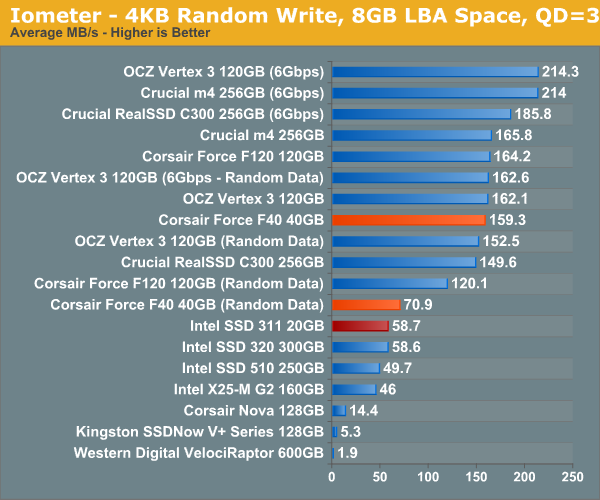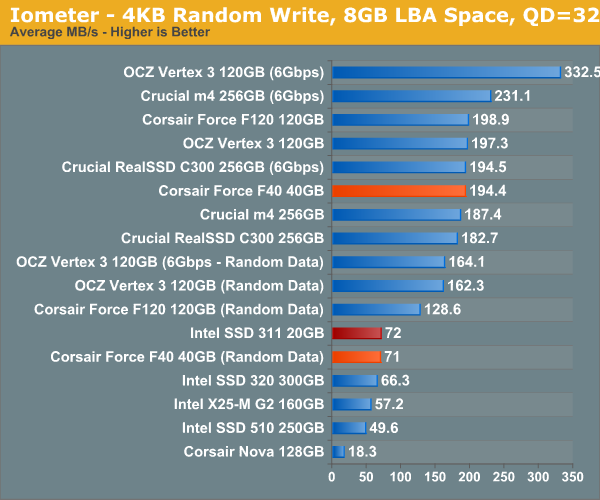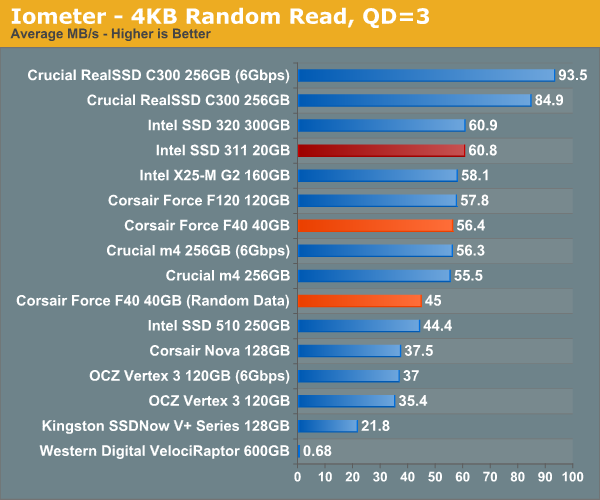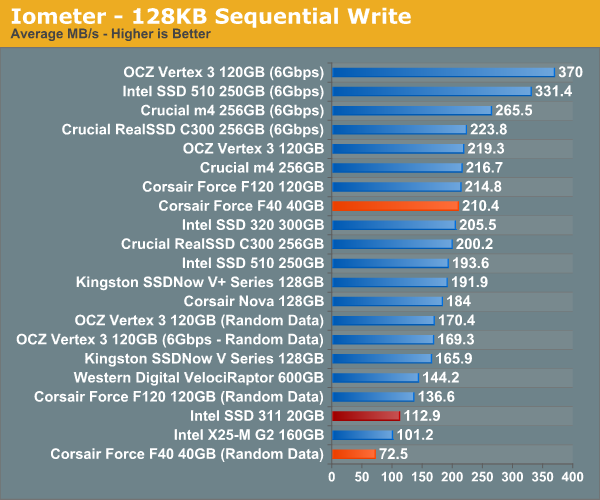Z68 SSD Caching with Corsair's F40 SandForce SSD
by Anand Lal Shimpi on May 13, 2011 3:06 AM ESTRandom/Sequential Read & Write Performance
To start with, let's look at how the Corsair Force F40 and Intel SSD 311 stack up. Remember that the F40 is based on SandForce's SF-1200 controller, meaning it gains its high performance by using real-time compression and deduplication techniques to reduce what it actually writes to NAND. Data that can easily be compressed is written as quickly as possible, while data that isn't as compressible goes by much slower. As a cache the drive is likely to encounter data from both camps, although Intel's SRT driver does filter out sequential file operations so large incompressible movies and images should be kept out of the cache altogether.
Peak sequential write performance is nearly double that of Intel's SSD 311. Toss incompressible (fully random) data at the drive however and it's noticeably slower. I'd say in practice the F40 is probably about the speed of the 311, perhaps a bit quicker in sequential writes.

For only having five NAND devices on board, Intel's SSD 311 boasts extremely high sequential read performance. At best the F40 equals it, but in reality the sequential read performance is likely a bit lower.

Random write performance is higher across the board, even with incompressible data. Random read/write performance is incredibly important for a cache, especially if most sequential data is kept off the cache to begin with. Things could be quite good for the F40 drive here.


Random read performance unfortunately doesn't look as good for the F40. Again, Intel's SSD 311 performs a lot like a X25-M G2, which happens to do very well in our random read test. At best the F40 is an equal performer, but at worst it's about 75% of the performance of the SSD 311.
Without a clear victory here, we'll likely see mixed results in our storage benchmark suite.











81 Comments
View All Comments
Dribble - Friday, May 13, 2011 - link
The reason being they are so common they are cheap. In the UK you can't get that 20GB Intel SSD yet, and while you could get the 40GB force (or vertex 2) the cost difference is very small - like I did you might as well get the 60GB vertex 2. I suspect a few others will do the same thing.Hence it would seem a good test.
The other thing I'd like to know is if you can buy a large capacity SSD (e.g. 240GB vertex 3) and then partition it giving 180GB to use as a boot drive, and the other 60GB to cache your monster games disk.
10Goto10 - Friday, May 13, 2011 - link
Or a 6Gb Sata Vertex3 240 GB, it should have enough IO, throughput and space to maintain both os and cache.Ryan Smith - Friday, May 13, 2011 - link
Yes, you can partition SSDs. In fact we've thrown around the exact same idea.10Goto10 - Friday, May 13, 2011 - link
According to the test hardware spec, the test is run on H67 not Z68, copy paste ;) ??mschira - Friday, May 13, 2011 - link
Would it be possible to get some SSD caching on a thinkpad t-series? they not only have a normal hard drive slot but they also have a miniPci slot for which they explicetly support small SSD to mount there...now having SSD caching would be great...
M.
DanNeely - Friday, May 13, 2011 - link
First page, the table lists an h67 mobo for the test, not a Z68jdavenport608 - Friday, May 13, 2011 - link
Both your articles about Z68 mention that SSD caching can be used in front of a RAID array. Do you plan on doing an article that describes the benefits or value of using a SSD cache in conjunction with different RAID arrays?weh69 - Friday, May 13, 2011 - link
I'd love to see results for a 60GB SSD as cache in front of a dual 2TB WD black RAID-1 array as the system drive.hechacker1 - Friday, May 13, 2011 - link
If that is possible, I would really like to see that too.Especially for a raid-5 config. Since write performance is limited so much by parity writes, having a cache could really help (on maximum mode).
kepstin - Friday, May 13, 2011 - link
This Intel SSD caching feature is a bit disappointing in one way.It's obvious that the caching work is done completely in software - in the Windows chipset driver, the same way as the motherboard RAID features work. There probably is some BIOS support required to boot off it though.
There's no technical reason why the same technology couldn't be used on other chipsets - it's just that Intel's decided to artificially limit it to the Z68...
I wouldn't be surprised if third-party tools and a generic Linux driver that can do the same thing on any chipset start showing up later this year.